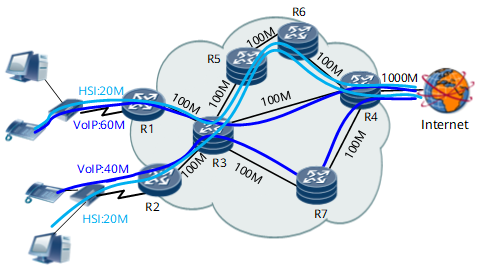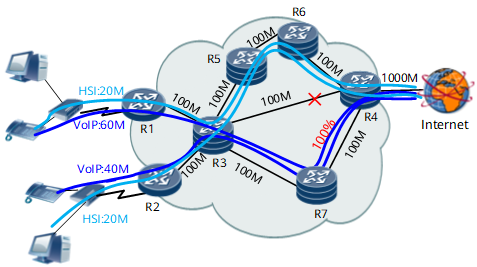Background
MPLS DS-TE Background
Advantages and disadvantages of MPLS TE
MPLS TE establishes an LSP by using available resources along links, which provides guaranteed bandwidth for specific traffic to prevent congestion occurring whenever the network is stable or failed. MPLS TE can also precisely control traffic paths so that existing bandwidth can be efficiently used.
MPLS TE, however, cannot provide differentiated QoS guarantees for traffic of different types. For example, there are two types of traffic: voice traffic and video traffic. Video frames may be retransmitted over a long period of time, so it may be required that video traffic be of a higher drop priority than voice traffic. MPLS TE does not classify traffic but integrates voice traffic and video traffic into the same drop priority.
Figure 1 MPLS TE
Advantages and disadvantages of the MPLS DiffServ model
The MPLS DiffServ model classifies user services and performs differentiated traffic forwarding behaviors based on the service class, meeting various QoS requirements. The DiffServ model provides good scalability. It is because data streams of multiple services are mapped to only several CoSs and the amount of information to be maintained is in direct proportion to the number of data flow types, not the number of data flows.
The DiffServ model, however, can reserve resources only on a single node. QoS cannot be guaranteed for the entire path.
Disadvantages of using both MPLS DiffServ and MPLS TE
In some usage scenarios, using MPLS DiffServ or MPLS TE alone cannot meet requirements.
For example, a link carries both voice and data services. To ensure the quality of voice services, you must lower voice traffic delays. The sum delay is calculated based on this formula:
Sum delay = Delay in processing packets + Delay in transmitting packets
The delay in processing packets is calculated based on this formula:
Delay in processing packets = Forwarding delay + Queuing delay
When the path is specified, the delay in transmitting packets remains unchanged. To shorten the sum delay for voice traffic, reduce the delay in processing voice packets on each hop. When traffic congestion occurs, the more packets, the longer the queue, and the higher the delay in processing packets. Therefore, you must restrict the voice traffic on each link.
In Figure 2, the bandwidth of each link is 100 Mbit/s, and all links share the same metric. Voice traffic is transmitted from R1 to R4 and from R2 to R4 at the rate of 60 Mbit/s and 40 Mbit/s, respectively. Traffic from R1 to R4 is transmitted along the LSP over the path R1 → R3 → R4, with the ratio of voice traffic being 60% between R3 and R4. Traffic from R2 to R4 is transmitted along the LSP over the path R2 → R3 → R7 → R4, with the ratio of voice traffic being 40% between R7 and R4.
If the link between R3 and R4 fails, as shown in Figure 3, the LSP between R1 and R4 changes to the path R1 → R3 → R7 → R4 because this path is the shortest path with sufficient bandwidth. At this time, the ratio of voice traffic from R7 to R4 reaches 100%, causing the sum delay of voice traffic to prolong.
MPLS DiffServ-Aware Traffic Engineering (DS-TE) can resolve this problem.
What Is MPLS DS-TE?
MPLS DS-TE combines MPLS TE and MPLS DiffServ to provide QoS guarantee.
The class type (CT) is used in DS-TE to allocate resources based on the service class. To provide differentiated services, DS-TE divides the LSP bandwidth into one to eight parts, each part corresponding to a CoS. Such a collection of bandwidths of an LSP or a group of LSPs with the same service class are called a CT. DS-TE maps traffic with the same per-hop behavior (PHB) to one CT and allocates resources to each CT.
Defined by the IETF, DS-TE supports up to eight CTs, marked CTi, in which i ranges from 0 to 7.
If an LSP has a single CT, the LSP is also called a single-CT LSP.

